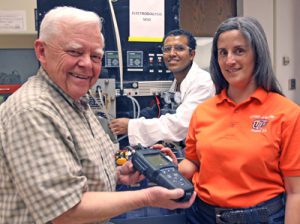Originally published March 29, 2013
By Nadia M. Whitehead
UTEP News Service
Water shortage is a serious issue in the Southwest United States and in many places across the world – more than 1.5 billion people will be living in regions with water scarcity by 2025 according to the United Nations.
Inland desalination is a solution that can help the issue, but improvements are needed to make it more affordable.
Current inland desalination plants throw away about 20 to 30 percent of the water recovered from deep underground aquifers because it’s heavily concentrated with salt – meaning two million gallons of potential drinking water goes to waste if a system is pumping some 10 million gallons of water a day.

“The way I think of it is, ‘We spent all this energy and money to bring this water up from underground, why throw it away?’” said Malynda Cappelle, associate director of The University of Texas at El Paso’s Center for Inland Desalination Systems (CIDS).
Since 2010, Cappelle has been leading the Zero Discharge Desalination (ZDD) project at UTEP – a new technology that has demonstrated a capability of at least 98 percent efficiency.
“The problem in normal systems is that you have a fairly large volume of salts that are left,” Cappelle said. “And you end up throwing away about a quarter of your water, and have to find a way to dispose of it.”
Disposal of the salty concentrate is a big problem for inland communities. While seawater desalination plants, and some brackish desalination plants, return their concentrated waste to the ocean, inland areas must finds ways to dispose of the waste by building expensive underground deep-well injection systems or evaporation ponds.
But with the use of ZDD, those expensive disposal methods are unnecessary, and even more water is recovered.
“Some places that want to build a desalination plant either can’t find a salty aquifer, or there are rules restricting their disposal options, so we are really trying to help those municipalities,” said Tom Davis, Ph.D., professor of civil engineering, director of CIDS and the original inventor of ZDD.
The UTEP researchers are working with Veolia Water Solutions & Technologies, a global water supply and treatment company, to commercialize the ZDD system to inland areas that have a great need for drinking water but have limited options for disposal of brackish waste.
Graduate student Alemayehu Yetayew, who is originally from Ethiopia, is currently conducting research and developing methods to find uses for the concentrated salt in the remaining two percent of processed water — an important step in achieving a goal of zero liquid waste.
So far, he has helped devise a method to recover pure salt from the leftover liquid concentrate, which could actually be quite useful.
According to Cappelle, the ZDD system uses a lot of salt during the water purification process, which could be expensive. For instance, if the system was producing four million gallons of water per day, about 60,000 pounds of salt would be needed each day.
However, if the salt is extracted and reused, a lot of money could be saved.
“The goal is to recover enough salt at a good enough purity and low enough cost so we can at least make it, at a minimum, the same cost as it is for us to buy salt,” Cappelle said.
In addition, Yetayew is figuring out how to recover other useful byproducts with what is left at the very end of the process that can be sold, which includes magnesium hydroxide, calcium sulfate and sodium sulfate.
“Magnesium hydroxide is worth $600 a ton if we can get it pure enough and into the market,” Cappelle said.
During this next year, the team plans to build a large-scale version of the system at Alamogordo’s Brackish Groundwater National Desalination Research Facility (BGNDRF). There may also be opportunities to test the system in eastern California, and perhaps even in Beverly Hills.
Yetayew, who hopes to return to his home country after graduation and start a consulting firm, is excited about the progress being made.
“Ethiopia does not have a lot of water resources and technology, and now, the whole world is needing water,” he said. “Desalination is the solution for the future, and we must solve these kinds of problems to provide fresh water to people who are in need of it.”